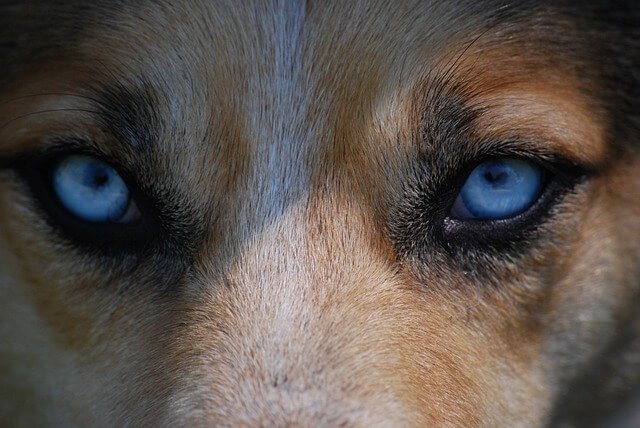Beagles have long captured the hearts of dog lovers around the world with their affectionate nature, boundless energy, and keen sense of smell. However, among the various traits that make Beagles so endearing, one rare and captivating feature stands out: their mesmerizing blue eyes. While not a common occurrence in the breed, Beagles with blue eyes possess a unique charm that sets them apart. In this article, I will delve into the phenomenon of Beagles with blue eyes, exploring the reasons behind this distinctive trait and the special allure these dogs hold.
Reasons for Beagles With Blue Eyes
Genetics and Inheritance
Beagles with Blue eyes are the result of a genetic anomaly that affects the expression of pigmentation in the iris. A dog’s eye color is primarily determined by the presence of melanin, the pigment responsible for the coloration of skin, hair, and eyes. Generally, brown eyes in Beagles are the most prevalent due to the high concentration of melanin, while blue eyes arise when there is a lack of melanin in the iris.
The genetic mutation that causes blue eyes can be inherited from both parents, and it is a recessive trait. This means that a Beagle must inherit the gene from both parents to have blue eyes. As a result, blue-eyed Beagles are relatively rare and considered somewhat of a genetic anomaly.
Distinctive Appeal
Beagles with blue eyes possess a unique and striking appearance that captivates dog enthusiasts and passersby alike. Their eyes, a mesmerizing hue of azure, stand out against their tricolor coats, creating a beautiful contrast that draws immediate attention. This distinctive appeal often makes them appear even more endearing and charming than their brown-eyed counterparts.
It is essential to note that the blue eyes do not alter the Beagle’s personality or temperament. They maintain their typical friendly, outgoing, and playful nature, making them wonderful companions for families, children, and individuals alike.
Cautionary Considerations
While Beagles with blue eyes are undoubtedly captivating, it is essential to be cautious about potential health concerns. The same genetic anomaly responsible for the blue eye color can be associated with certain health issues, especially in dogs that have a predominantly white coat. Such health concerns may include congenital deafness, eye problems, or increased sensitivity to sunlight.
Responsible breeding practices are crucial in maintaining the health and well-being of Beagles, regardless of their eye color. Prospective Beagle owners should choose reputable breeders who prioritize the health and temperament of their dogs over aesthetic traits.

FAQ
What does it mean if a dog has blue eyes?
Simply put, when a dog’s eye appears blue, it is often due to corneal edema, a condition where the cornea becomes swollen with fluid. Several reasons can lead to corneal edema or a blue eye in dogs, including endothelial corneal dystrophy, glaucoma, lens luxation, trauma, and inflammatory conditions. These factors contribute to the distinct blue appearance observed in the affected dog’s eye.
What is the rarest beagle eye color?
While Beagles can have various eye colors, the rarest eye color for this breed is blue. Blue eyes in Beagles are not very common and are considered a unique and captivating trait. As mentioned earlier, blue eyes in Beagles result from a genetic anomaly that affects the expression of pigmentation in the iris, leading to a lack of melanin. This rarity makes Beagles with blue eyes particularly alluring to dog lovers and collectors who appreciate their distinctiveness and charm.
It’s essential to remember that the rarity of blue eyes in Beagles does not affect their personality, temperament, or overall health. Responsible breeding practices are crucial to maintaining the well-being and happiness of Beagles, regardless of their eye color or coat variation. As with any dog breed, it is essential to prioritize the health and welfare of these wonderful companions over specific aesthetic traits.
How long do puppies eyes stay blue?
The duration that a puppy’s eyes stay blue can vary depending on the breed and individual genetics. In most cases, puppies are born with blue eyes, which is a result of the lack of melanin in their developing irises. As they grow and their bodies produce more melanin, the eye color typically begins to change.
For many dog breeds, including Beagles, the eye color starts to transition from blue to its final color by the time the puppy is around 6 to 8 weeks old. By 8 weeks of age, most puppies’ eyes have settled into their permanent color, which can be shades of brown, amber, green, or other colors, depending on the breed.
However, it’s important to note that some breeds with a genetic predisposition for blue eyes, such as Siberian Huskies or Border Collies, may retain their blue eye color for a more extended period, sometimes up to several months. This phenomenon is known as “puppy blue eyes,” and it is considered normal as long as there are no other concerning symptoms or issues with the puppy’s eyesight.
If a puppy’s eyes do not start to change color as they age or if there are other eye-related concerns, it’s best to consult a veterinarian for a thorough examination. In most cases, though, the beautiful blue eyes of puppyhood eventually give way to the adult eye color as the pup grows and matures.
Do all dogs start with blue eyes?
No, not all dogs start with blue eyes. While some dog breeds are born with blue eyes, it is not a universal trait across all breeds. The eye color of a puppy is determined by genetics, and it can vary widely depending on the breed’s characteristics and individual genetics.
When puppies are born, their eyes are often closed, and they remain closed for the first week or two of their lives. As they develop and open their eyes, the initial color of their irises may be blue, gray, or even darker shades like brown or black, depending on the breed.
Some dog breeds, especially those with a genetic predisposition for lighter coat colors or merle patterns, are more likely to be born with blue eyes. Breeds such as Siberian Huskies, Border Collies, Australian Shepherds, and Dalmatians are known for occasionally having blue-eyed individuals.
As puppies age, their eye color can change as the amount of melanin in their irises increases. This is why many puppies with blue or gray eyes will eventually develop brown, amber, green, or other eye colors as they grow older.
It’s important to remember that the presence of blue eyes in puppies doesn’t necessarily mean they will have blue eyes as adults. The final eye color is determined by the interplay of genetics and the production of melanin as the puppy matures.
Conclusion
Beagles with blue eyes are a delightful rarity in the canine world, showcasing the marvels of genetic diversity. Their striking appearance, coupled with their friendly and affectionate nature, makes them truly enchanting companions for dog lovers everywhere. However, responsible ownership and breeding practices should always be observed to ensure the overall well-being and happiness of these lovable creatures.
If you are fortunate enough to encounter Beagles with blue eyes, take a moment to appreciate the extraordinary beauty and uniqueness they bring to the world of dogs. Celebrate their individuality, and above all, cherish the love and joy that these wonderful Beagles are eager to share with their human companions.

